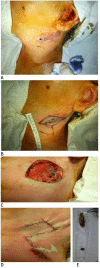Controversies in the diagnosis and treatment of early cutaneous melanoma
- PMID: 25866567
- PMCID: PMC4392104
Controversies in the diagnosis and treatment of early cutaneous melanoma
Abstract
Cutaneous melanoma (CM) is a disease with an unpredictable evolution mainly due to its high metastatic ability. The steadily increasing incidence and the poor outcome in advanced stages made this cancer an interesting field for many research groups. Given that CM is a curable disease in early stages, efforts have been made to detect it as soon as possible, which led to the diversification and refining of diagnosis methods and therapies. But, as the data from trials have been published, doubts about the indications and efficacy of established treatments have arisen. In fact, there is probably no single aspect of early CM that has not given birth to controversy. This article intends to present the current disputes regarding the early detection, diagnosis, treatment and postoperative follow-up of patients with localized CM. After analyzing both pros and cons, several conclusions were drawn, that reflect our experience in managing patients with early CM.
Keywords: diagnosis; early cutaneous melanoma; follow-up; treatment.
Figures


Similar articles
-
Diagnosis and treatment protocols of cutaneous melanoma: latest approach 2010.Chirurgia (Bucur). 2010 Sep-Oct;105(5):637-43. Chirurgia (Bucur). 2010. PMID: 21141087 Review.
-
Current trends and controversies in cutaneous melanoma.Scott Med J. 2010 May;55(2):36-40. doi: 10.1258/rsmsmj.55.2.36. Scott Med J. 2010. PMID: 20533701
-
Analysis of disease free survival in cutaneous melanoma patients subject to sentinel lymph node biopsy.Pol Przegl Chir. 2020 Mar 3;92(3):15-21. doi: 10.5604/01.3001.0013.9041. Pol Przegl Chir. 2020. PMID: 32759393
-
Update on Current Treatment Recommendations for Primary Cutaneous Melanoma.Dermatol Clin. 2019 Oct;37(4):397-407. doi: 10.1016/j.det.2019.06.001. Epub 2019 Jul 18. Dermatol Clin. 2019. PMID: 31466581 Review.
-
Cutaneous melanoma in the elderly.Melanoma Res. 2009 Jun;19(3):125-34. doi: 10.1097/CMR.0b013e328329fe95. Melanoma Res. 2009. PMID: 19381113 Review.
Cited by
-
An analysis of clinical effectiveness of electrochemotherapy in the treatment of advanced metastatic malignant melanoma performed in the eastern part of Central Europe: a single-centre experience.Postepy Dermatol Alergol. 2022 Jun;39(3):559-564. doi: 10.5114/ada.2022.117528. Epub 2022 Jul 14. Postepy Dermatol Alergol. 2022. PMID: 35950133 Free PMC article.
-
Biopsy Techniques for Skin Disease and Skin Cancer: A New Approach.J Cutan Aesthet Surg. 2020 Jul-Sep;13(3):251-254. doi: 10.4103/JCAS.JCAS_173_19. J Cutan Aesthet Surg. 2020. PMID: 33209007 Free PMC article.
-
Epigenomic and genomic analysis of transcriptome modulation in skin cutaneous melanoma.Aging (Albany NY). 2020 Jul 7;12(13):12703-12725. doi: 10.18632/aging.103115. Epub 2020 Jul 7. Aging (Albany NY). 2020. PMID: 32639949 Free PMC article.
-
Bulk and single-cell RNA-sequencing analyses along with abundant machine learning methods identify a novel monocyte signature in SKCM.Front Immunol. 2023 May 25;14:1094042. doi: 10.3389/fimmu.2023.1094042. eCollection 2023. Front Immunol. 2023. PMID: 37304304 Free PMC article.
-
Cutaneous Malignant Melanoma: A Review of Early Diagnosis and Management.World J Oncol. 2021 Feb;12(1):7-19. doi: 10.14740/wjon1349. Epub 2021 Feb 24. World J Oncol. 2021. PMID: 33738001 Free PMC article. Review.
References
-
- Weinstock MA. Early detection of melanoma. JAMA. 2000 Aug 16;284(7):886–889. - PubMed
-
- Dzwierzynski WW. Managing malignant melanoma. Plast Reconstr Surg. 2013 Sep;132(3):446e–460e. - PubMed
-
- Nestle FO, Kerl H. Melanoma In Dermatology. by Bolognia J, Jorrizo J, Rapini R. Mosby. 2003:1789–1815.
-
- Lesage C, Barbe C, Le Clainche A, Lesage FX, Bernard P, Grange F. Sex-related location of head and neck melanoma strongly argues for a major role of sun exposure in cars and photoprotection by hair. J Invest Dermatol. 2013 May;133(5):1205–1211. - PubMed
-
- Balch CM, Gershenwald JE, Soong SJ, Thompson JF, Atkins MB, Byrd DR, Buzaid AC, Cochran AJ, Coit DG, Ding S, Eggermont AM, Flaherty KT, Gimotty PA, Kirkwood JM, McMasters KM, Mihm MC Jr, Morton DL, Ross MI, Sober AJ, Sondak VK. Final version of the American Joint Committee on Cancer staging system for cutaneous melanoma. J J Clin Oncol. 2009 Dec 20;27(36):6199–6206. - PMC - PubMed
Publication types
MeSH terms
LinkOut - more resources
Full Text Sources
Medical
Miscellaneous
